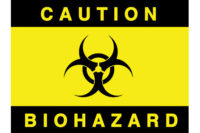Damaged cargo can be costly to a business.
It can result in lost materials, lost customers, citations and a poor company image. Worse, improperly secured cargo can lead to traffic incidents and injuries to workers. For these reasons, the Federal Motor Carrier Safety Administration has strict regulations pertaining to the protection of cargo.
Proper cargo securement starts with the right planning and well before the loading process begins. Considerations include travel route review, load weight, cargo covering, type of trailer being used, load rating of the trailer floor, axle load ratings, anchor points for strapping and proper spacing of the cargo. It is also critical to adhere to Federal Motor Carrier Safety Regulation Part 392.9, which covers cargo inspection and securement devices, as well as FMCSR Part 393, which outlines specific provisions.
Any commercial motor vehicle with a gross vehicle weight rating exceeding 10,000 lb. falls under FMCSR standards. Vehicles used to transport hazardous materials in quantities that require placards, are also covered under the auspices of this standard, regardless of their GVWR.
Trailers can provide some securement (floor, walls, shoring bars, etc.) for cargo, but in many cases this is not enough. Be sure your trailer has the resources needed to ensure proper securement of the load(s) during transport. This includes bracing bars, dunnage, tie-downs, winch straps, ratchet straps, wood blocks and friction mats. Other tips for cargo securement are highlighted in Toolbox Talk atwww.asa.net/safety.
Tie-downs, such as chains, webbing, cordage and rope are a common part of the cargo securement system. The number of tie-downs to be used depends on their strength, the length and weight of the cargo, and whether the cargo is prevented from moving forward. If cargo is not prevented from moving forward, additional requirements apply. A good rule of thumb is to go beyond the minimum number of tie-downs in case one fails.
Camera systems also can be a helpful tool in managing cargo securement responsibilities. They are available in color or in black/white models. Common systems include two, three or four cameras. Suggested areas for mounting include side mirrors, rear tailgate and in locations that provide a visual of the rear door(s). These camera systems vary in cost (dependent on the quality of the system desired) and can be easily installed in a day. They can also be set up to record and have sound. Other options include the use of proximity sensors or sensor products that can detect the shifting of cargo.
Transportation of hazardous materials, along with driving and parking rules, are identified under FMCSA Part 397. This standard covers HAZMAT regulations, which includes but is not limited to routing of radioactive and nonradioactive hazardous materials, preemption procedures and considerations for fires, smoking, fueling and tires.
Part 397 also details a variety of other HAZMAT-related issues such as dispute resolution, waiver processing and what steps are required to properly attend the commercial motor vehicle. As a general rule, any motor vehicle containing explosive materials must be attended to at all times by the driver or a qualified representative of the motor carrier that operates it. There are some exceptions to this rule, so it is recommended to review Part 397, Subpart A for clarification of driver responsibilities pertaining to attendance and surveillance of the motor vehicle.
Cargo securement is best accomplished by a qualified driver who has received appropriate training. For new drivers, it is recommended to complete online and hands-on training on cargo securement prior to performing any securement activities. For tenured drivers, it is suggested to complete refresher training on an annual basis, or more frequently if needed.
Properly secured cargo is a key step in a successful freight delivery process. It reduces the chance for traffic incidents and can help keep workers safe. Taking the time to do it right will make your customers happy and keep drivers (and their organizations) free of securement-related citations. For more information on FMCSR standards for cargo securement, or to review educational resources, visitwww.fmcsa.dot.gov.




